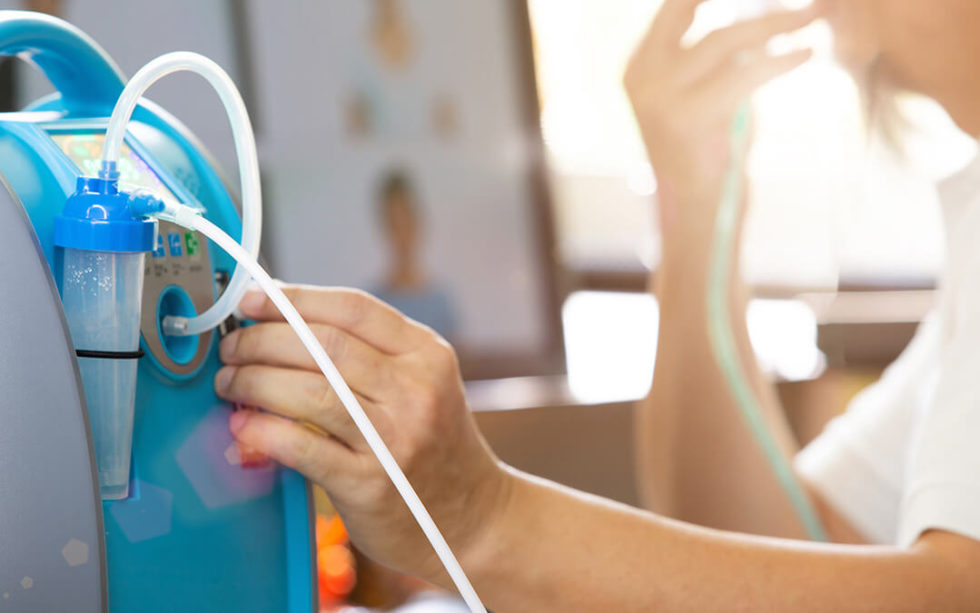Home Oxygen Therapy for COPD
Easy Breathing at Home: A Comprehensive Guide to Oxygen Therapy for COPD
Breathing becomes challenging when you have chronic obstructive pulmonary disease (COPD), a progressive lung disease. Some patients may need additional oxygen therapy at home when their COPD worsens in order to control their symptoms and enhance their quality of life. This article examines home oxygen therapy, including its indications, various delivery methods, and crucial safety factors.
Table of Contents

Comprehending COPD Oxygen Therapy
Home Oxygen Therapy for COPD
Your body suffers from a disease known as hypoxemia when your lungs are unable to provide your bloodstream with enough oxygen. Fatigue, dyspnea, and other issues may result from this oxygen deficiency. For COPD patients with chronic hypoxemia, home oxygen therapy delivers a regulated supply of extra oxygen to raise blood oxygen levels and alleviate symptoms.
Who Requires Oxygen Therapy at Home?
Home Oxygen Therapy for COPD
Not all COPD patients need home oxygen therapy. Based on the severity of your disease, especially your resting blood oxygen levels, your doctor will determine what you need. Here are a few broad recommendations:
- Arterial blood gas (ABG) test: The arterial blood gas (ABG) test quantifies the concentrations of carbon dioxide and oxygen in your blood. Oxygen treatment may be suggested if your resting oxygen level is below a certain threshold (often less than 88%).
- Signs: Even when at rest or with little exertion, severe dyspnea may indicate that oxygen therapy is necessary.
- Life quality: If oxygen shortage has a major negative influence on your everyday life, home oxygen therapy can help you feel better and be more active.
Choosing at-home oxygen therapy: advantages and things to think about
Home Oxygen Therapy for COPD
Even though home oxygen therapy has many advantages, it’s important to know what to expect before beginning treatment.
Advantages:
- Better Symptoms: More oxygen helps reduce exhaustion, ease breathlessness, and enhance the quality of sleep.
- Enhanced Activity: Patients can live more actively and participate in everyday activities more easily when their oxygenation is improved.
- Decreased Hospitalizations: Oxygen treatment can lessen the need for hospital admissions by preventing problems.
Taking into account
Home Oxygen Therapy for COPD
- Long-term Commitment: Home oxygen therapy is often used for an extended period of time, and therapeutic adherence is essential.
- Portability: Mobility may be restricted by certain systems, notwithstanding their portability.
- Psychological Adjustment: It may be necessary to make some emotional adjustments when using oxygen treatment, and assistance can be beneficial.
Methods of Supplying Oxygen Therapy at Home
Home Oxygen Therapy for COPD
Supplemental oxygen can be given at home in a number of ways. Your physician will advise you on the best system based on your needs and way of life.
- Stationary Concentrators: These electrical machines provide concentrated oxygen by using the surrounding air. They offer a steady supply of oxygen and are usually used at home.
- Liquid Oxygen Systems: Systems for storing liquid oxygen, which vaporizes to produce breathable gas, are known as liquid oxygen systems. They need to be refilled but provide some portability.
- Compressed oxygen cylinders: Compressed oxygen gas is stored in these transportable tanks. Despite being portable, they have a finite amount of oxygen and need to be filled frequently.
- Oxygen Conserving Devices (OCDs): These devices maximize efficiency and prolong the life of your oxygen supply by delivering oxygen in pulses during inhalation.
Safety Issues with Oxygen Therapy at Home
Home Oxygen Therapy for COPD
Although home oxygen therapy is generally safe, it is important to take some precautions:
- Safety around fires: Oxygen is very combustible. Avoid placing oxygen near heat sources, cigarettes, and open fires.
- Quitting Smoking: Because smoking increases the risk of fire, it is strictly forbidden when receiving oxygen therapy.
- Signs of Distress: Keep an eye out for any symptoms, such as breathing difficulties, disorientation, or blue-tinged lips (cyanosis), that could indicate an oxygen supply shortage or malfunction.
- Continual Upkeep: To guarantee optimal performance, adhere to your doctor’s instructions for routine maintenance of your oxygen equipment.
Getting Healthy at Home with Oxygen Therapy
Home Oxygen Therapy for COPD
If you have COPD, home oxygen therapy can greatly enhance your quality of life. Securing a safe and efficient experience requires careful collaboration with your physician, selection of an appropriate delivery method, and adherence to safety guidelines. Asking your doctor any questions or feeling worried about home oxygen therapy is a good idea.
Home Oxygen Therapy for COPD
You can live a fuller life with COPD and breathe easier with home oxygen therapy if you engage with your healthcare team, prioritize safety, and are aware of the benefits and considerations.


